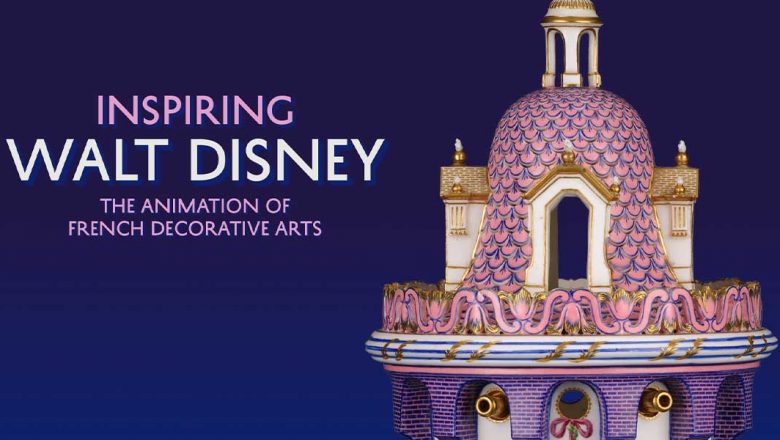By Beth Deitchman
For the first time ever, The Metropolitan Museum of Art in New York City will feature the work of Walt Disney Animation Studios’ hand-drawn animation in a new exhibition opening December 10, 2021, and continuing through March 6, 2022. Inspiring Walt Disney: The Animation of French Decorative Arts will draw new parallels between the magical creations of the Disney Studios and their artistic models, examining Walt Disney’s personal fascination with European art and the use of French motifs in Disney films and theme parks.
Visitors to the exhibition will find 150 production artworks and works on paper from the Walt Disney Animation Research Library, Walt Disney Archives, Walt Disney Imagineering Collection, and Walt Disney Family Museum on display alongside 40 works of 18th-century European decorative arts and design—from tapestries and furniture to Boulle clocks and Sèvres porcelain. Additionally, select film footage will highlight the extraordinary technological and artistic developments of the studios during Walt Disney’s lifetime and beyond. Inspiring Walt Disney will also shine a light on references to European visual culture that can be found in so many Disney classes, from the Gothic Revival architecture seen in Cinderella (1950) and medieval influences on Sleeping Beauty (1959), to the Rococo-inspired objects that are brought to life in Beauty and the Beast (1991).
Organized thematically and broadly chronologically, the exhibition will explore Walt Disney’s strong connection to France, highlighting his encounters with European art and architecture during his repeated visits to Western Europe. These visits influenced Walt and his studios throughout his life, and also inspired his passion for collecting and building miniature furniture and dollhouse contents. Several of these mini objects will be displayed alongside personal film footage of Walt and his family visiting Paris and Versailles.
Through a presentation of French and German Rococo porcelain figurines alongside story sketches for two of Disney’s “Silly Symphonies”—The Clock Store (1931) and The China Shop (1934)—the exhibition will explore the concept of “Animating the Inanimate.” The whimsical porcelain figures featured in the exhibition were originally inspired by the pastoral scenes of French Rococo painter Antoine Watteau and his contemporaries, and they, in turn, inspired the first generation of Disney animators.
A section focused on Snow White and the Seven Dwarfs, inspired by the Brothers Grimm fairytale, includes a gouache on celluloid depicting two avid-eyed vultures from the film, which Walt Disney presented to The Met in 1938. The Cinderella section will spotlight the barrier-breaking female artists who entered the creative realm of the Disney Studios, including Bianca Majolie and Mary Blair. The latter’s bold and highly colorful style was the driving force behind the look of the studios’ feature films of the 1940s and early 1950s. And visitors will also learn about the medieval sources that Eyvind Earle and his fellow artists looked to as they created Sleeping Beauty. These include The Hunt of the Unicorn tapestries (1495–1505; also known as the Unicorn Tapestries) from The Met Cloisters’ collection, which are often credited for providing a starting point for the film’s visual development.
The exhibition marks the 30th anniversary of Beauty and the Beast’s animated theatrical release and the largest section of Inspiring Walt Disney is devoted to the beloved film. The expansive section will explore topics of anthropomorphism and zoomorphism in 18th-century French literature and decorative arts, Disney’s satirical take on Rococo fashion, the interiors of the movie’s enchanted castle, and the design and animation of the Beast and other characters. Movie sketches will be seen alongside the 18th century clocks, candlesticks, and teapots that may have inspired Cogsworth, Lumiere, and Mrs. Potts and illustrate how both Disney animators and Rococo craftspeople found ways to bring these inanimate objects to life. Beast’s transformation scene, which was animated by Glen Keane and inspired by sculptor Auguste Rodin’s The Burghers of Calais, will be spotlighted, along with Beauty and the Beast’s beloved ballroom scene, whose backdrop calls to mind the Hall of Mirrors at Versailles. And a “Be Our Guest” display will look at the ways glittering silver and porcelain buffets were part of the festivities at Versailles and other European courts.
A final section looks at Disney architecture with a focus on the iconic castles that are so much a part of Disney movies and theme parks. Though these stunning structures transcend specific styles and time periods, the exhibition will explore how Disney artists were heavily influenced by French and German architecture when creating their settings, particularly for amusement parks. Included in the exhibition are a presentation of Walt Disney Imagineering concept art; the first bird’s-eye view of Disneyland, drawn by Herbert Ryman under Walt Disney’s guidance in 1953; and the only two pairs of so-called Tower vases, made by Sèvres around 1762–63 and likely to be reunited for the first time in history. These enchanting vases were designed to spark the imagination in much the same way that Disney’s castles do.
“Both Disney animated films and Rococo decorative works of art are infused with elements of playful storytelling, delight, and wonder,” said Max Hollein, Marina Kellen French Director of The Met. “Eighteenth-century craftspeople and 20th-century animators alike sought to ignite feelings of excitement, awe, and marvel in their respective audiences. Through exquisite objects and Disney artifacts, this exhibition will provide an unprecedented look at the impact of French art on Disney Studios productions from the 1930s to almost the present day.”
“In mounting The Met’s first-ever exhibition devoted to Walt Disney and his studios’ oeuvre, it was important for us to explore his sources of inspiration as well as to recognize that his studio’s animated interpretations of European fairytales have become a lens through which many view Western art and culture today,” said Wolf Burchard, the exhibition’s curator. “Our fresh look on this material, which prompts an effervescent dialogue between the drawings and illustrations of some of the most talented artists in the Walt Disney Animation Studios and a rich array of the finest 18th-century furniture and porcelain, brings to life the humor, wit, and ingenuity of French Rococo decorative arts.”
Sarah Lawrence, Iris and B. Gerald Cantor Curator in Charge of European Sculpture and Decorative Arts, shared, “Burchard brings a wholly original response to his subject, one that enriches our appreciation of Disney’s art of animation and enlivens our delight in the decorative arts of 18th-century France. The genius of Walt Disney and his studio was to have intuited the animation implicit in these ornate furnishings and then to discover a technology that brings those objects to life.”
Inspiring Walt Disney is organized in collaboration with The Wallace Collection in London, where the exhibition will open in spring 2022. To learn more about the upcoming exhibition and to keep up with the latest details, visit The Met website.





